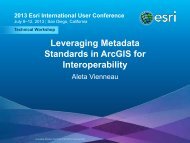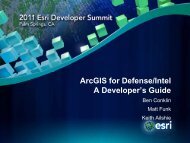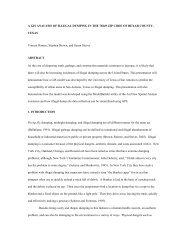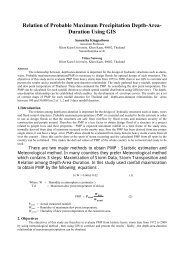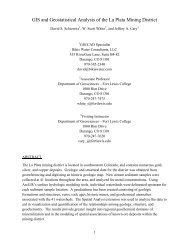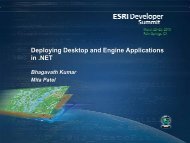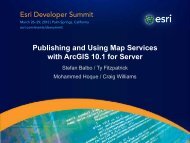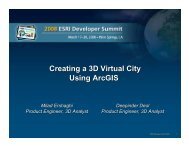A Data Model for Representing Cities in Three Dimensions - Esri
A Data Model for Representing Cities in Three Dimensions - Esri
A Data Model for Representing Cities in Three Dimensions - Esri
You also want an ePaper? Increase the reach of your titles
YUMPU automatically turns print PDFs into web optimized ePapers that Google loves.
A <strong>Data</strong> <strong>Model</strong> <strong>for</strong> <strong>Represent<strong>in</strong>g</strong> <strong>Cities</strong><br />
<strong>in</strong> <strong>Three</strong> <strong>Dimensions</strong><br />
Harvard University<br />
Graduate School of Design<br />
Presented by Paul Cote<br />
ESRI User Conference August 2008
Harvard University<br />
Graduate School of Design<br />
Abstract<br />
This talk will describe an ArcGIS Geodatabase model<br />
and model-builder toolkit <strong>for</strong> organiz<strong>in</strong>g and<br />
visualiz<strong>in</strong>g three-dimensional city models. This<br />
simple relational database schema provides means of<br />
organiz<strong>in</strong>g 3d model assets and retriev<strong>in</strong>g logically<br />
consistent visualizations of the city at different time<br />
periods, proposed development scenarios, and at<br />
appropriate levels of detail. The presentation will<br />
discuss the extension of this model with reference to<br />
the emerg<strong>in</strong>g Build<strong>in</strong>g In<strong>for</strong>mation Spatial <strong>Data</strong> <strong>Model</strong><br />
BIM Standards and CityGML.<br />
Paul Cote. ESRI UC 2008<br />
2
Harvard University<br />
Graduate School of Design<br />
F<strong>in</strong>d<strong>in</strong>gs:<br />
To build a data model <strong>for</strong> build<strong>in</strong>gs, campuses and<br />
cities, requires that we build a schema to represent<br />
many different types of features that are <strong>in</strong>ter-related.<br />
We should:<br />
Avoid the usual home-grown, seat-of-the-pants<br />
problem solv<strong>in</strong>g strategy and participate <strong>in</strong><br />
community-based data model<strong>in</strong>g work<br />
Anticipate the need to exchange data between<br />
different specialized software tools<br />
Encourage our vendors to support community<br />
based data model<strong>in</strong>g ef<strong>for</strong>ts and vendor neutral<br />
<strong>for</strong>mats <strong>for</strong> data exchange!<br />
Paul Cote. ESRI UC 2008<br />
3
Harvard University<br />
Graduate School of Design<br />
Acknowledgement<br />
This work was made possible by fund<strong>in</strong>g by the Town<br />
of Brookl<strong>in</strong>e, Massachusetts Department of<br />
Management In<strong>for</strong>mation Systems. Feng Yang,<br />
Director.<br />
Paul Cote. ESRI UC 2008<br />
4
Evolution and Susta<strong>in</strong>ability<br />
We’ve seen plenty of demos, but how can we evolve<br />
our municipal GIS <strong>in</strong>frastructure to <strong>in</strong>corporate 3d<br />
build<strong>in</strong>g models that are a solid, susta<strong>in</strong>able part of our<br />
<strong>in</strong>frastructure?<br />
Susta<strong>in</strong>able evolution of municipal <strong>in</strong>frastructure will:<br />
Make use of exist<strong>in</strong>g GIS layers<br />
Build on the scalable relational (table-based) data<br />
structure of GIS<br />
Extend GIS data models to deal with true 3d data<br />
Require <strong>in</strong>teroperability with 3d model<strong>in</strong>g tools and<br />
new Build<strong>in</strong>g In<strong>for</strong>mation <strong>Model</strong><strong>in</strong>g Tools<br />
Reliable cross-vendor <strong>in</strong>teroperability will depend on<br />
stable open <strong>in</strong>terchange standards<br />
Harvard University<br />
Graduate School of Design<br />
Paul Cote. ESRI UC 2008<br />
5
Today’s GIS Infrastructure<br />
Traditional layers <strong>in</strong> a municipal GIS <strong>in</strong>frastructure are<br />
two dimensional:<br />
Property Parcels<br />
Build<strong>in</strong>g Footpr<strong>in</strong>ts<br />
Orthophotography<br />
Edge of Pavement<br />
Photogrammetric Contours<br />
Harvard University<br />
Graduate School of Design<br />
Paul Cote. ESRI UC 2008<br />
6
2.5 Dimensional <strong>Model</strong>s From 2d GIS<br />
Height In<strong>for</strong>mation can be added to 2D GIS data to<br />
develop two and a half dimensional models <strong>for</strong><br />
visualization<br />
Build<strong>in</strong>gs may be Extruded<br />
Contours and Edge of Pavement may be turned<br />
<strong>in</strong>to ground surface models as Triangulated<br />
Irregular Networks (TIN)<br />
Orthophotography or thematic <strong>in</strong><strong>for</strong>mation may be<br />
draped on surfaces<br />
Harvard University<br />
Graduate School of Design<br />
Paul Cote. ESRI UC 2008<br />
7
GIS as Basis <strong>for</strong> 3D <strong>Model</strong>s<br />
GIS tools like ArcGIS are not suited to mak<strong>in</strong>g true 3d<br />
<strong>Model</strong>s, but GIS <strong>in</strong><strong>for</strong>mation <strong>in</strong>frastructure is very<br />
useful as a basis <strong>for</strong> detailed 3d model<strong>in</strong>g.<br />
Represents consistent, controlled geometry over<br />
broad area<br />
Provides rough 2.5-D mass<strong>in</strong>g context<br />
Harvard University<br />
Graduate School of Design<br />
Paul Cote. ESRI UC 2008<br />
8
GIS -> 3D <strong>Model</strong><strong>in</strong>g Interoperability<br />
Transferr<strong>in</strong>g data (<strong>in</strong>teroperability) between GIS and<br />
3d <strong>Model</strong><strong>in</strong>g tools has been a very difficult process<br />
until a few years ago.<br />
Common CAD <strong>for</strong>mats (DWG/DXF) does not pass<br />
<strong>in</strong><strong>for</strong>mation <strong>for</strong> extrusion<br />
ESRI has no way of <strong>in</strong>terchang<strong>in</strong>g TIN <strong>in</strong><strong>for</strong>mation to<br />
DWG / DXF<br />
Harvard University<br />
Graduate School of Design<br />
Paul Cote. ESRI UC 2008<br />
9
Sketchup Interoperability<br />
Sketchup is a 3d model<strong>in</strong>g tool that deals with<br />
georeferenc<strong>in</strong>g and <strong>in</strong>teroperability with geospatial<br />
tools.<br />
Capable of gett<strong>in</strong>g terra<strong>in</strong> with draped aerial<br />
photos from Google Earth or ArcGIS<br />
Capable of gett<strong>in</strong>g extruded mass<strong>in</strong>g models from<br />
ArcGIS<br />
Very rich capabilities <strong>for</strong> mak<strong>in</strong>g 3d models<br />
<strong>Model</strong>s may be encapsulated as COLLADA files<br />
COLLADA files may be dealt with as s<strong>in</strong>gular data<br />
objects <strong>in</strong> a database or Google 3d Warehouse<br />
Vendors of 3d model<strong>in</strong>g tools are rush<strong>in</strong>g to<br />
<strong>in</strong>corporate generic COLLADA import and export.<br />
Harvard University<br />
Graduate School of Design<br />
Paul Cote. ESRI UC 2008<br />
10
Incorporat<strong>in</strong>g true 3d models with GIS not only<br />
provides a rich visualization tool, but also a means of<br />
manag<strong>in</strong>g large collections of models.<br />
Harvard University<br />
Graduate School of Design<br />
Paul Cote. ESRI UC 2008<br />
11
Workflow <strong>for</strong> Develop<strong>in</strong>g City <strong>Model</strong><br />
Selection of <strong>Model</strong><br />
Elements<br />
Terra<strong>in</strong>, Mass<strong>in</strong>g, 3d<br />
Build<strong>in</strong>gs<br />
Based on Date or Scheme<br />
Export to CAD or<br />
Render<strong>in</strong>g System<br />
Render<strong>in</strong>g:<br />
Hi Quality (e.g. 3d Studio)<br />
Web-Based (e.g. Google<br />
Earth)<br />
Creat<strong>in</strong>g new model<br />
elements<br />
Upload of new model<br />
elements to repository<br />
Harvard University<br />
Graduate School of Design<br />
Paul Cote. ESRI UC 2008<br />
12
Concern about Vendor-Specific Exchange<br />
Formats<br />
Nobody should build an <strong>in</strong>frastructure that depends<br />
on vendor specific arrangements <strong>for</strong> <strong>in</strong>terchang<strong>in</strong>g<br />
proprietary data <strong>for</strong>mats!<br />
Despite the best <strong>in</strong>tentions, <strong>in</strong>teroperability may<br />
cease to work as software features change<br />
COLLADA is an exchange <strong>for</strong>mat ma<strong>in</strong>ta<strong>in</strong>ed by a<br />
consortium (Khronos) that is regulated by a<br />
consortium of vendors, its specification is open<br />
and has stable well documented versions.<br />
At version 9.3 ArcGIS will be able to import a<br />
COLLADA file and convert it to its own 3d <strong>Data</strong><br />
<strong>for</strong>mat (multipatch). YAY!<br />
Harvard University<br />
Graduate School of Design<br />
Paul Cote. ESRI UC 2008<br />
13
Vendor Neutral Exchange: COLLADA<br />
COLLAborative Design Activity<br />
Standards Consortium:<br />
Khronos Group<br />
Communities:<br />
Visualization<br />
Gam<strong>in</strong>g<br />
Capabilities:<br />
Very rich visual and physical simulation: photorealistic<br />
shaders, cameras, movement<br />
No semantic model<br />
No georeferenc<strong>in</strong>g<br />
<strong>Model</strong><strong>in</strong>g / Encod<strong>in</strong>g<br />
UML / XML<br />
Adoption:<br />
Many 3d author<strong>in</strong>g tools, 3d Studio, Sketchup …<br />
The vehicle <strong>for</strong> textured models <strong>in</strong> Google Earth<br />
Harvard University<br />
Graduate School of Design Paul Cote. ESRI 14
GIS Management of 3D Build<strong>in</strong>g <strong>Model</strong>s<br />
The availability of sketchup and the <strong>in</strong>teroperability<br />
with Google Earth and ArcGIS is lead<strong>in</strong>g to the<br />
development of lots of georeferenced 3d build<strong>in</strong>g<br />
models. We need a systematic means of organiz<strong>in</strong>g<br />
these assets<br />
Visualiz<strong>in</strong>g large models requires different levels<br />
of detail <strong>for</strong> distant or up-close render<strong>in</strong>g:<br />
<strong>Cities</strong> change, we need to be able to render<br />
temporal scenarios build<strong>in</strong>gs based on year built<br />
and year demolished<br />
Need fictitious design schemes with proposed<br />
build<strong>in</strong>gs and demolitions<br />
Harvard University<br />
Graduate School of Design<br />
Paul Cote. ESRI UC 2008<br />
15
Build<strong>in</strong>g <strong>Model</strong> Management Schema<br />
Abstract Build<strong>in</strong>gs<br />
Build<strong>in</strong>g ID<br />
Attributes…<br />
Harvard University<br />
Graduate School of Design<br />
1<br />
n<br />
n<br />
Schemes<br />
Scheme ID<br />
Name<br />
Sk<strong>in</strong> Parts<br />
Build<strong>in</strong>g ID<br />
Part ID<br />
Attributes…<br />
Mass<strong>in</strong>g Parts<br />
Build<strong>in</strong>g ID<br />
Part ID<br />
Attributes…<br />
1 n<br />
n<br />
n<br />
1<br />
Scheme Parts<br />
Scheme_ID<br />
Part ID<br />
Render<br />
Paul Cote. ESRI UC 2008<br />
1<br />
16
New Table: Abstract Build<strong>in</strong>gs<br />
The Parcels table can <strong>for</strong>m a table of <strong>in</strong><strong>for</strong>mation about<br />
build<strong>in</strong>gs. Unique Build<strong>in</strong>g IDs are created from Parcel IDs.<br />
This table has no geometry associated with it. Any build<strong>in</strong>g<br />
associated with a parcel are designated Build<strong>in</strong>g 0. This<br />
lump<strong>in</strong>g is <strong>in</strong>accurate, but sufficient <strong>for</strong> an <strong>in</strong>itial build<strong>in</strong>gs<br />
table.<br />
B0<br />
Cam_P364234<br />
Harvard University<br />
Graduate School of Design<br />
Abstract Build<strong>in</strong>gs<br />
Territory Cambridge<br />
Build<strong>in</strong>g Cam_P364234_B0<br />
Owner Harvard<br />
Built Date 1870<br />
Demo<br />
Date<br />
Null<br />
Address 49 Qu<strong>in</strong>cy St<br />
Stories 5<br />
17
New Layer: Build<strong>in</strong>g Mass<strong>in</strong>g Parts<br />
Where <strong>in</strong>dividual build<strong>in</strong>g parts vary <strong>in</strong> terms of their attributes, they may be<br />
dist<strong>in</strong>guished with unique IDs and <strong>in</strong>dividual build and demo dates, etc. The<br />
Build<strong>in</strong>g Mass<strong>in</strong>g Part IDs are <strong>for</strong>med by append<strong>in</strong>g a Mass<strong>in</strong>g Part ID to the<br />
Build<strong>in</strong>g ID.<br />
B0_M1<br />
Cam_P364234<br />
B0_M0<br />
Harvard University<br />
Graduate School of Design<br />
Build<strong>in</strong>g Mass<strong>in</strong>g Parts<br />
Part_ID Cam_P364234_B0_M1<br />
Owner Null<br />
Built<br />
Date<br />
Demo<br />
Date<br />
1998<br />
Null<br />
Address Null<br />
Stories 2<br />
18
3d Build<strong>in</strong>g Mass<strong>in</strong>g Parts <strong>Model</strong><br />
The Mass<strong>in</strong>g Parts Layer <strong>for</strong>ms a complete model of every build<strong>in</strong>g <strong>in</strong> the<br />
metro area at a low level of detail (CityGML LOD2). Build<strong>in</strong>g parts may have<br />
more specific attributes from their parent Abstract Build<strong>in</strong>gs.<br />
B0_M0<br />
B0_M1<br />
Harvard University<br />
Graduate School of Design<br />
Build<strong>in</strong>g Mass<strong>in</strong>g Parts<br />
Part_ID Cam_P364234_B0_M1<br />
Owner Null<br />
Built<br />
Date<br />
Demo<br />
Date<br />
1998<br />
Null<br />
Address Null<br />
Built Yes<br />
Stories 2<br />
19
3d Build<strong>in</strong>g Sk<strong>in</strong> <strong>Model</strong>s<br />
Us<strong>in</strong>g a 3D author<strong>in</strong>g tool, models of build<strong>in</strong>g exterior sk<strong>in</strong>s can be<br />
encapsulated as sketchup or collada models and placed <strong>in</strong>to relational tables<br />
as georeferenced objects. Like Mass<strong>in</strong>g Parts, Sk<strong>in</strong> Parts have unique IDs<br />
l<strong>in</strong>k<strong>in</strong>g them to abstract build<strong>in</strong>gs and may have more specific attributes.<br />
Cam_P364234<br />
B0_S0<br />
Harvard University<br />
Graduate School of Design<br />
Build<strong>in</strong>g Sk<strong>in</strong> Parts<br />
Shape Multipatch<br />
<strong>Model</strong> Sketchup or Collada<br />
Blob<br />
Part_ID Cam_P364234_B0_S0<br />
Owner Null<br />
Build<br />
Date<br />
Demo<br />
Date<br />
1870<br />
Null<br />
Built Yes<br />
20
3d Build<strong>in</strong>g Sk<strong>in</strong> Parts<br />
Sk<strong>in</strong> parts and mass<strong>in</strong>g parts <strong>for</strong> a given build<strong>in</strong>g may have <strong>in</strong>dependent dates.<br />
The <strong>Model</strong> field holds a B<strong>in</strong>ary Large Object that can be downloaded to a 3d<br />
author<strong>in</strong>g tool <strong>for</strong> edit<strong>in</strong>g.<br />
Cam_P364234<br />
B0_S1<br />
Harvard University<br />
Graduate School of Design<br />
Build<strong>in</strong>g Sk<strong>in</strong> Parts<br />
Shape Multipatch<br />
<strong>Model</strong> Sketchup or Collada<br />
Blob<br />
Part_ID Cam_P364234_B0_S1<br />
Owner Null<br />
Buid<br />
Date<br />
Demo<br />
Date<br />
2001<br />
Null<br />
Built Yes<br />
21
Built and Unbuilt Scenarios<br />
The Built attribute is set to Yes <strong>for</strong> build<strong>in</strong>gs that were actually built. Unbuilt<br />
build<strong>in</strong>gs can be represented <strong>in</strong> the schema to allow experimentation with<br />
proposed scenarios.<br />
Cam_P364223_B0_S0<br />
Harvard University<br />
Graduate School of Design<br />
Build<strong>in</strong>g Sk<strong>in</strong> Parts<br />
Shape Multipatch<br />
<strong>Model</strong> Sketchup or Collada<br />
Blob<br />
Part_ID Cam_P364223_B0_S0<br />
Owner Null<br />
Built<br />
Date<br />
Demo<br />
Date<br />
2001<br />
Null<br />
Built Yes<br />
22
Built and Unbuilt Scenarios<br />
The Built attribute is set to Yes <strong>for</strong> build<strong>in</strong>gs that were actually built. Unbuilt<br />
build<strong>in</strong>gs can be represented <strong>in</strong> the schema to allow experimentation with<br />
proposed scenarios.<br />
Cam_P364223_B0_S1<br />
Harvard University<br />
Graduate School of Design<br />
Build<strong>in</strong>g Sk<strong>in</strong> Parts<br />
Shape Multipatch<br />
<strong>Model</strong> Sketchup or Collada<br />
Blob<br />
Part_ID Cam_P364223_B0_S1<br />
Owner Null<br />
Built<br />
Date<br />
Demo<br />
Date<br />
2001<br />
Null<br />
Built No<br />
23
Relational Queries Create Views Based on Dates<br />
or Scenarios<br />
Build<strong>in</strong>g Sk<strong>in</strong> Parts<br />
Year<br />
Demo<br />
Shape Multipatch Address<br />
<strong>Model</strong> Sketchup or Collada<br />
Blob<br />
Stories<br />
Harvard University<br />
Graduate School of Design<br />
Abstract Build<strong>in</strong>gs<br />
Territory<br />
Build<strong>in</strong>g<br />
Owner<br />
Year Built<br />
Part_ID Cam_P364234_B0_S1<br />
Owner Null<br />
Built 2001<br />
Demo Null<br />
Built Yes<br />
Cambridge<br />
Cam_P364234_B0<br />
Harvard<br />
1870<br />
Null<br />
49 Qu<strong>in</strong>cy Part_ID St Cam_P364234_B0_M1<br />
5<br />
Build<strong>in</strong>g Mass<strong>in</strong>g Parts<br />
Owner Null<br />
Built 1998<br />
Demo Null<br />
Address Null<br />
Stories 2<br />
24
The Scheme View Tool<br />
Harvard University<br />
Graduate School of Design Paul Cote, 2008<br />
A tool has been created<br />
with all of the SQL to<br />
create the three views<br />
necessary to portray a<br />
Date and Scheme<br />
Specific Scenario<br />
based on the user’s<br />
privileges. One needs<br />
only to double-click on<br />
the tool and fill <strong>in</strong> the<br />
blanks.<br />
25
Harvard University<br />
Graduate School of Design<br />
Current Built View<br />
26
Harvard University<br />
Graduate School of Design<br />
1998 Historic View<br />
27
Unbuilt Scheme: Turn Gund Hall Around<br />
Harvard University<br />
Graduate School of Design<br />
28
View From Proposed Design Scheme<br />
Harvard University<br />
Graduate School of Design
1<br />
Build<strong>in</strong>g <strong>Model</strong> Management Schema<br />
Abstract Build<strong>in</strong>gs<br />
Build<strong>in</strong>g ID<br />
Attributes…<br />
1<br />
Schemes<br />
Scheme ID<br />
Name<br />
Sk<strong>in</strong> Parts<br />
Build<strong>in</strong>g ID<br />
Part ID<br />
Attributes…<br />
Mass<strong>in</strong>g Parts<br />
Build<strong>in</strong>g ID<br />
Part ID<br />
Attributes…<br />
Harvard University<br />
Graduate School of Design Paul Cote. ESRI<br />
n<br />
n<br />
1 n<br />
n<br />
n<br />
1<br />
30<br />
Scheme Parts<br />
Scheme_ID<br />
Part ID<br />
Render<br />
1
The Scheme View Tool<br />
Harvard University<br />
Graduate School of Design Paul Cote. ESRI<br />
A tool has been created<br />
with all of the SQL to<br />
create the three views<br />
necessary to portray a<br />
Date and Scheme<br />
Specific Scenario<br />
based on the user’s<br />
privileges. One needs<br />
only to double-click on<br />
the tool and fill <strong>in</strong> the<br />
blanks.<br />
31
Extend<strong>in</strong>g to Interior Spaces<br />
This<br />
This<br />
3d<br />
3d<br />
<strong>Model</strong><br />
<strong>Model</strong><br />
Schema<br />
Schema<br />
is<br />
is<br />
compatible<br />
compatible<br />
with<br />
with<br />
the<br />
the<br />
Penobscot<br />
Penobscot<br />
Bay<br />
Bay<br />
/<br />
/<br />
ESRI<br />
ESRI<br />
data<br />
data<br />
model<br />
model<br />
<strong>for</strong><br />
<strong>for</strong><br />
<strong>in</strong>terior<br />
<strong>in</strong>terior<br />
spaces.<br />
spaces.<br />
Harvard University<br />
Graduate School of Design<br />
Paul Cote. ESRI UC 2008<br />
32
1<br />
Build<strong>in</strong>g <strong>Model</strong> Management Schema<br />
Abstract Build<strong>in</strong>gs<br />
Build<strong>in</strong>g ID<br />
Attributes…<br />
Harvard University<br />
Graduate School of Design<br />
1<br />
n<br />
n<br />
Interior Spaces<br />
Interior Spaces<br />
Build<strong>in</strong>g ID<br />
Build<strong>in</strong>g ID<br />
Part ID<br />
Part ID<br />
Attributes…<br />
Attributes…<br />
Sk<strong>in</strong> Parts<br />
Build<strong>in</strong>g ID<br />
Part ID<br />
Attributes…<br />
Mass<strong>in</strong>g Parts<br />
Build<strong>in</strong>g ID<br />
Part ID<br />
Attributes…<br />
Paul Cote. ESRI<br />
n<br />
n<br />
33
Expect Problems with Interrelated <strong>Model</strong>s<br />
Expect problems, and you will rarely be disappo<strong>in</strong>ted!<br />
What are some problems that we can expect with<br />
merg<strong>in</strong>g <strong>in</strong>terior spaces with build<strong>in</strong>g exterior models<br />
Opportunity <strong>for</strong> audience participation!<br />
Harvard University<br />
Graduate School of Design<br />
Paul Cote. ESRI UC 2008<br />
34
Build<strong>in</strong>g In<strong>for</strong>mation <strong>Model</strong>s<br />
Build<strong>in</strong>g In<strong>for</strong>mation <strong>Model</strong><strong>in</strong>g is essentially the<br />
application of GIS data model<strong>in</strong>g concepts to<br />
build<strong>in</strong>gs.<br />
Build<strong>in</strong>g <strong>in</strong><strong>for</strong>mation developed and used <strong>in</strong><br />
Design, Construction, Facilities Operation,<br />
Demolition is <strong>in</strong>tegrated <strong>in</strong>to a s<strong>in</strong>gle model<br />
Many tools are capable of creat<strong>in</strong>g and analyz<strong>in</strong>g<br />
BIM<br />
The ability to exchange <strong>in</strong><strong>for</strong>mation among these<br />
tools allows toolmakers to specialize and users to<br />
have a choice of tools<br />
Harvard University<br />
Graduate School of Design<br />
Paul Cote. ESRI UC 2008<br />
35
Harvard University<br />
Graduate School of Design<br />
IFC<br />
In order to have <strong>in</strong>teroperability between the various<br />
specialized tools used <strong>in</strong> the Architecture Eng<strong>in</strong>eer<strong>in</strong>g,<br />
Construction and Facilities Management requires<br />
exchange of structured <strong>in</strong><strong>for</strong>mation.<br />
The emerg<strong>in</strong>g exchange standard <strong>for</strong><br />
<strong>in</strong>teroperability <strong>in</strong> the BIM world is IFC: Industry<br />
Foundation Class<br />
IFC is a stable, open specification of a consortium<br />
of vendors and large users of build<strong>in</strong>g data.<br />
Even though IFC is very thorough and<br />
complicated, simple profiles <strong>for</strong> <strong>in</strong>terior spaces<br />
have been developed<br />
Paul Cote. ESRI UC 2008<br />
36
Vendor Neutral Exchange: IFC<br />
Industry Foundation Classes<br />
Standards Consortium:<br />
International Alliance <strong>for</strong> Interoperability (IAI<br />
Build<strong>in</strong>gSmart)<br />
Communities:<br />
Architecture Eng<strong>in</strong>eer<strong>in</strong>g and Construction<br />
Facilities Management<br />
Capabilities:<br />
Very rich semantic model <strong>for</strong> build<strong>in</strong>g systems and<br />
relationships<br />
<strong>Model</strong><strong>in</strong>g / Encod<strong>in</strong>g<br />
EXPRESS / STEP, XML<br />
Adoption:<br />
Very broad adoption <strong>in</strong> author<strong>in</strong>g tools <strong>for</strong> Build<strong>in</strong>g<br />
In<strong>for</strong>mation <strong>Model</strong><strong>in</strong>g (BIM)<br />
Requirement <strong>for</strong> many big build<strong>in</strong>g customers e.g. U.S.<br />
General Services Adm<strong>in</strong>istration<br />
Harvard University<br />
Graduate School of Design<br />
Paul Cote. ESRI UC 2008<br />
37
IFC <strong>Model</strong> Views may be Very Simple<br />
Slide taken from NBIMS V1<br />
Harvard University<br />
Graduate School of Design Paul Cote. ESRI<br />
38
Harvard University<br />
Graduate School of Design<br />
Solution:<br />
The makers of BIM author<strong>in</strong>g tools like Autodesk,<br />
Graphisoft and Bentley and others have implemented<br />
import and export of IFC <strong>for</strong> exchange of <strong>in</strong>terior<br />
space data.<br />
ESRI should make an IFC importer to populate the<br />
<strong>in</strong>terior spaces model.<br />
BIM author<strong>in</strong>g tools should export COLLADA<br />
models of build<strong>in</strong>g sk<strong>in</strong>s at different levels of<br />
detail with attributes, ready <strong>for</strong> import <strong>in</strong>to GIS<br />
data models.<br />
Paul Cote. ESRI UC 2008<br />
39
Harvard University<br />
Graduate School of Design<br />
More Problems<br />
What are some more problems that we can expect <strong>in</strong><br />
<strong>in</strong>tegrat<strong>in</strong>g build<strong>in</strong>g models with other elements of city<br />
models?<br />
Build<strong>in</strong>g models and terra<strong>in</strong> models need to meet<br />
each other at the right place witout awkward<br />
<strong>in</strong>tersections<br />
We need to model terra<strong>in</strong> at different levels of<br />
detail<br />
Need to model vegetation at different levels of<br />
detail.<br />
Build<strong>in</strong>gs and roads and other outdoor features<br />
have important relationships.<br />
Many different communities and specialized tools<br />
will be necessary to build these models.<br />
Paul Cote. ESRI UC 2008<br />
40
Vendor Neutral Exchange: CityGML<br />
City Geographic Markup Language<br />
Standards Consortium:<br />
Open Geospatial Consortium (Best Practice Specification)<br />
Communities:<br />
Photogrammetry<br />
Municipal Geospatial Infrastructure (Ma<strong>in</strong>ly <strong>in</strong> Europe)<br />
Capabilities:<br />
Very rich semantic model <strong>for</strong> city objects and relationships<br />
5 predef<strong>in</strong>ed levels of detail<br />
Image textures supported<br />
<strong>Model</strong><strong>in</strong>g / Encod<strong>in</strong>g<br />
UML / XML / GML3 Profile<br />
Adoption:<br />
Berl<strong>in</strong>, Bonn and many other German cities<br />
Compatible with OGC Web Feature Services<br />
Harvard University<br />
Graduate School of Design<br />
Paul Cote. ESRI UC 2008<br />
41
CityGML is Adapted <strong>for</strong> <strong>Model</strong><strong>in</strong>g Semantics of<br />
Observable Objects<br />
Robot:<br />
Mobilerobots.com.<br />
Photo:<br />
DirectionsMagaz<strong>in</strong>e<br />
www.aeromapss.com/lidar.htm<br />
Harvard University<br />
Graduate School of Design<br />
Paul Cote. ESRI UC 2008 42
CityGML: Eng<strong>in</strong>eered objects relate to various<br />
terra<strong>in</strong> surfaces<br />
Image from OGC CityGML Discussion paper, Kolbe, Groeger, Czerw<strong>in</strong>ski<br />
Harvard University<br />
Graduate School of Design<br />
Paul Cote. ESRI UC 2008<br />
43
CityGML: Objects May Honor Specific Levels of<br />
Detail<br />
Image from OGC CityGML Discussion paper, Kolbe, Groeger, Czerw<strong>in</strong>ski<br />
Harvard University<br />
Graduate School of Design<br />
Paul Cote. ESRI UC 2008<br />
44
CityGML can provide a Spatially Exhaustive<br />
Semantically Rich model of the city<br />
Image from OGC CityGML Discussion paper, Kolbe, Groeger, Czerw<strong>in</strong>ski<br />
Harvard University<br />
Graduate School of Design<br />
Paul Cote. ESRI UC 2008<br />
45
CityGML: Transportation Objects<br />
Image from OGC CityGML Discussion paper, Kolbe, Groeger, Czerw<strong>in</strong>ski<br />
Harvard University<br />
Graduate School of Design<br />
Paul Cote. ESRI UC 2008<br />
46
Harvard University<br />
Graduate School of Design<br />
Conclusion:<br />
To build data models <strong>for</strong> build<strong>in</strong>gs and cities, we will<br />
build a conta<strong>in</strong>er <strong>for</strong> many different types of features<br />
that are <strong>in</strong>ter-related.<br />
We should:<br />
Avoid the usual home-grown, seat-of-the-pants<br />
problem solv<strong>in</strong>g strategy and participate <strong>in</strong><br />
community-based data model<strong>in</strong>g work<br />
Anticipate the need to exchange data between<br />
different specialized software tools<br />
Encourage our vendors to support community<br />
based data model<strong>in</strong>g ef<strong>for</strong>ts and vendor neutral<br />
<strong>for</strong>mats <strong>for</strong> data exchange!<br />
Paul Cote. ESRI UC 2008<br />
47
References and Resources<br />
Demo <strong>Data</strong> and Full Documentation:<br />
http://www.gsd.harvard.edu/pbcote/research/brookl<strong>in</strong>e<br />
Build<strong>in</strong>g In<strong>for</strong>mation Spatial <strong>Data</strong> <strong>Model</strong>:<br />
http://www.bisdm.org<br />
Industry Foundation Classes (IFC):<br />
http://www.iai-<strong>in</strong>ternational.org<br />
http://www.facility<strong>in</strong><strong>for</strong>mationcouncil.org/bim/<br />
City Geography Markup Language:<br />
http://www.citygml.org/<br />
Contact: pbcote@gsd.harvard.edu<br />
Harvard University<br />
Graduate School of Design<br />
Paul Cote. ESRI UC 2008<br />
48




